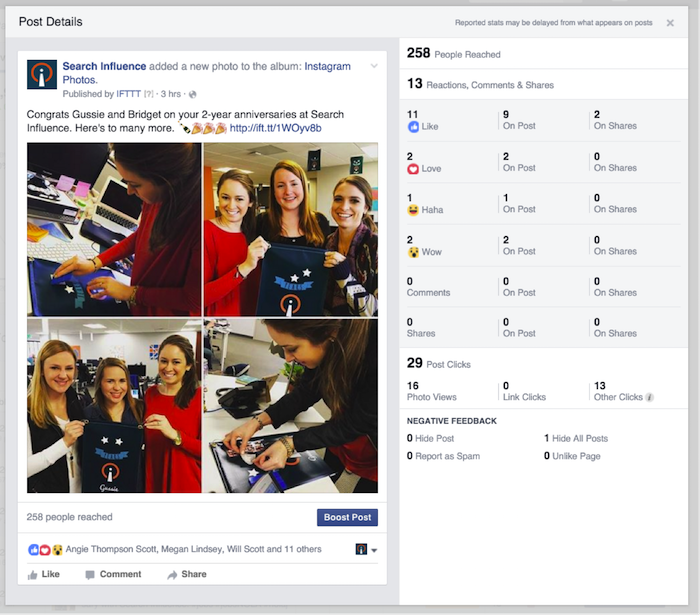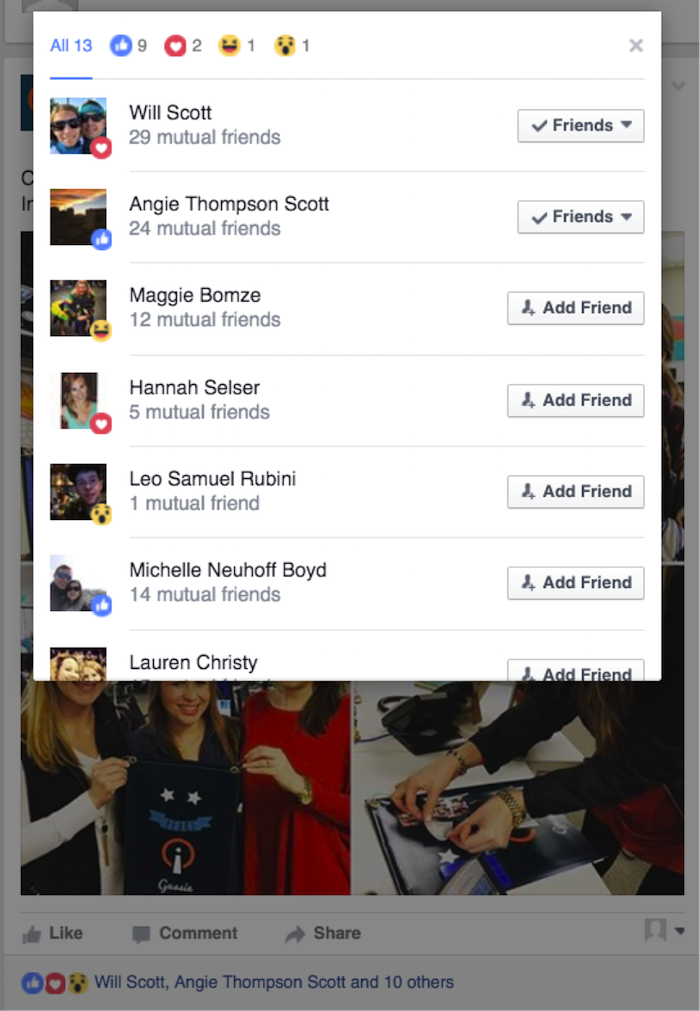How to React to Facebook Reactions: All Your Business Needs to Know
March 4th, 2016 by
Here is my take on what businesses and marketers need to know about Reactions and how the change will impact our data.
How is Facebook tracking Reaction data?
- Right now, Facebook is including all Reactions bundled together for the metrics on “Likes” in ads, and in the top level of Page Insights.
- It’s also good to note that “Reactions are treated the same as Likes for ads delivery (ex: Loves carry no extra weight than Likes in the auction).”
- Until Facebook (or a social media analytics software company) rolls out a more efficient way to look at the individual Reaction data, it’s going to need to be done manually.
Let’s check out the different ways we can view data in this example of a post with 13 total Reactions (9 Likes, 2 Loves, 1 Haha, and 1 Wow):
- To see the Reactions from individual Facebook users, click on the liked row of names at the bottom of the post from your Page’s Timeline:


- To see total reactions on the broadest level, check out the Posts section on your Page’s Insights tab:


- View individual Reaction data by clicking on the post text on the Overview or Posts section of your Page’s Insights (this one is my personal favorite):


- Note that this data is NOT currently included in exports.
What can I learn from analyzing my customers’ Reactions?
If you are willing to put in the manual labor, there’s a lot you can do!
- Marketers can create better content by examining trends in their #FB Reactions. Click To TweetIf you are seeing lots of “Love,” it’s a good indicator that your customers will want to see more posts like that. Don’t forget to use the data to actually change the way you are writing posts in the future.
- You may also want to test out different types of posts, with goals of evoking different emotions. For example, if The Center for Restorative Breast Surgery were to post about a heart-wrenching breast cancer story, they might expect to receive a higher number of “Sad” Reactions. On the flip side, if they post an inspiring survivor story, they may see more “Love” and “Wow” Reactions.
What changes will this bring about in the future?
As of now, we haven’t heard from big players in Social Media analytics, such as Sprout Social, Socialbakers, and Hootsuite. But I have no doubt they are working on it! It’s my hope that these companies can provide lots of easy-to-analyze data that will empower marketers and business owners to make the right decisions behind content creation and relationship building with customers online.
- Facebook will be counting Reactions the same as Likes for News Feed influence…for now. Eventually, they do plan to use the data later for more targeted News Feeds.
- Potentially, the use of more emotions could drive Reactions up, and comments down. If people are able to click “Haha,” they might be less likely to spend their time and energy commenting “LOL.”
- There has been a constant shift to shorter attention spans, so we will have to monitor Reactions vs. Comments on similar posts from before and after the change.
- Something I would love to see as a marketer is the ability to track conversions on your website with users who gave a certain individual Reaction. I’d also love to serve unique ads to users who emoted beyond the Like, but it might be a while until that’s a possibility.


I love the new Reactions because they are going to allow businesses to connect with customers on a much more personal level. I will love them more when I can get some cold, hard (and easier to access) data behind them, but for now, we are moving in the right direction!
What is your take on Reactions for businesses and marketers? Let me guess: it’s either like, love, haha, wow, sad, or angry! ?
Image Source:


Great post Maggie! I too would love to see conversion by reaction. How many angry people end up on your site would be in interesting metric to understand.